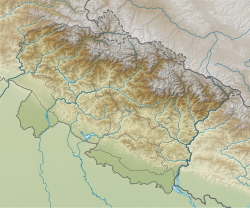Damage and casualties
Severe ground deformations resulted from the earthquake. Formation of ground fissures were reported from many areas. Landslides and changes in the groundwater flow were also reported. Well-developed ground cracks were seen in Gopeshwar, Chamoli and Bairagna. Cracks were observed in asphalt roads at several locations. [4] Landslips cut off parts of Mandakini valley and Mandal valley and many major roads. [6]
The death toll was 103. [3] Several hundred people were injured and approximately 50,000 houses were damaged. [7] Over 2,000 villages were affected by the earthquake. [8] Electricity, water supply and communication were also severely affected by the earthquake especially in the Chamoli town, Gopeshwar and Okhimath region of Rudraprayag district. [6] According to Mike Wooldridge, correspondent for the BBC News, Chamoli suffered most damage and almost all the houses and shops built on slopes in the lower part of the town were destroyed. [5]
The bridge deck of a pedestrian suspension bridge situated near Bairagna developed lateral buckling and the cables of the bridge were loosened. Water pipelines in Chamoli and Gopeshwar towns were damaged affecting water supply due to landslides caused by the quake. The concrete-lined canals of the irrigation network in the affected region sustained some cracks. [4]
In Delhi, many buildings sustained non-structural damage. [9] According to Dr B.L. Wadhera, who filed a public interest litigation in the Delhi High Court, cracks developed in the Shastri Bhavan in Delhi which houses several Union Ministries. [10] Damage occurred in several buildings in Dehradun also. A few old buildings of the Survey of India sustained collapse of gable masonry, and cracks developed along the junctions between the pitched roof and the masonry walls. [4]
This page is based on this
Wikipedia article Text is available under the
CC BY-SA 4.0 license; additional terms may apply.
Images, videos and audio are available under their respective licenses.

